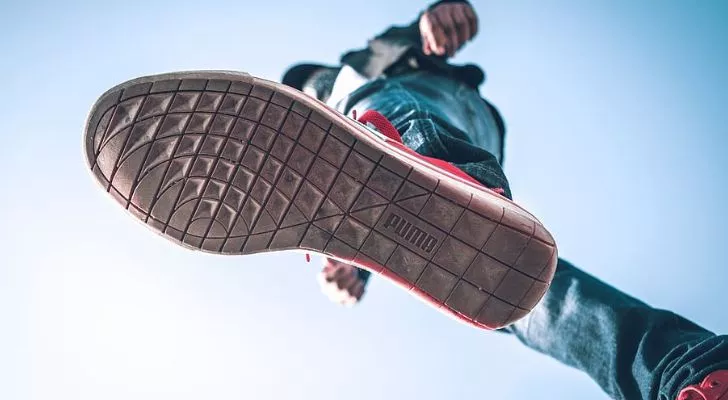Puma is one of the biggest sportswear brands in the world.
But to achieve this, Puma had to be strategic with their marketing efforts and investing decisions toward the people promoting their products.
As you read this article, you’ll discover Puma’s history and how particular years made them what they are today.
The founder of Puma, Rudolf Dassler, is the brother of the man who founded Adidas. Rudolf started a shoe company called Gebrüder Dassler with his brother, Adolf “Adi” Dassler, before parting ways and building their own brand.
Rudolf founded Puma in 1948 — a year earlier than the establishment of Adidas. However, at the start of this year, the brand name “Puma” still didn’t exist.
At this time, the brand was known as “Ruda,” which was derived from Rudolf’s name – just like Adidas.
Only in October 1948 was the name “Puma” registered at the German Patent and Trademark Office. And according to the founder himself, Puma got its name because he wanted people to associate his products with the characteristics of a Puma cat’s speed, strength, endurance, and agility.
Puma’s first logo was a Puma cat leaping through an elongated letter D. It took three more rebrands to create the logo we know today.
The creator of Puma’s iconic logo was Lutz Backes, a German caricaturist, who could’ve been a multi-millionaire had he chosen commissions (which Puma offered) instead of a one-off payment.
Puma signed a sponsorship deal with Usain Bolt when he was only 16 years old. The sportswear brand said in 2003 that it was the biggest deal they’ve ever done with a track and field athlete. And they were hoping Bolt could help them increase brand awareness and sales — the same way Michael Jordan did with Nike.
Super Atom was historic for Puma as it began the brand’s dominance in football. These cleats were made in 1952, following the first cleats of Puma: Atom.
In the 1968 Summer Olympic Games in Mexico City, the International Amateur Athletic Federation (IAAF) banned Puma’s brush spike shoe since it had 68 spikes — sixty more than the maximum number of spikes allowed for track shoes at the time.
Selena Gomez became a brand ambassador for Puma in 2017, signing a two-year contract worth over $30 million! The sportswear brand has also signed other celebrities like Rihanna, the Weeknd, and even Hailie Jade, Eminem’s daughter!
Pelé, a legendary football player, was paid a whopping $120,000 in the 1970 FIFA World Cup to tie his Puma football boots! This was done despite their pact with Adidas called the “Pelé Pact,” which was an agreement that both brands won’t make a deal with the legendary soccer player.
For Puma’s female empowerment or Do You campaign in 2016, they organized a planking event in Mumbai, India, that resulted in 1,623 women holding an abdominal plank position for at least 60 seconds.
One of the most influential sneakers in history is Puma Suede due to Tommie Smith, famously known for the Black Power salute during the 1968 Olympics in Mexico. He did it by raising his right fist as a sign of fighting against racial discrimination during the American national anthem right after winning a gold medal for the 200-meter race.
Walt “Clyde” Frazier, an NBA legend who played for the New York Knicks, signed an endorsement deal with Puma in 1971. It led to the creation of the Puma Clyde in 1973, a Puma Suede designed for basketball with the name “Clyde” below Puma’s logo, which made Frazier the first NBA player to receive a signature shoe.
Puma is more popular than Nike or Adidas in India despite only entering India’s sportswear market in 2006. They became the leading sportswear brand there in 2015 by identifying market trends, making localized marketing campaigns, and partnering with Indian celebrities like Bollywood actors, actresses, and cricket players.
Puma signed Jay-Z as their creative director for Puma basketball in 2018, while Beyonce collaborated with Adidas in 2019 to relaunch Ivy Park — Beyonce’s athleisure clothing line.
Puma launched a computer shoe called Puma RS-Computer in 1986. It had a computer chip built at the back of the shoe that tracks your steps and calories, just like what most smartwatches today can do. This was also the same year that Puma became a public company.
Puma signed a contract worth $100 million with a 19-year-old basketball player named Lamelo Ball before he got drafted into the NBA in 2020. The sportswear brand then released Lamelo Ball’s first signature shoe, MB.01, a year after.
Puma collaborated with the creators of Rick and Morty to create eye-popping shoes like the Puma RS-X and a mismatched colorway for Lamelo Ball’s first signature shoes. They also made an exclusive Rick and Morty apparel collection.
The manufacturer of Puma’s socks and bodywear is Dobotex, also the manufacturer of some products for brands like Levi’s and Tommy Hilfiger. And in 2009, Puma became its majority shareholder, leading to an acquisition in 2012.
A trainer shoe made by Puma named “Storm Adrenaline” was said to look like Adolf Hitler. And speaking of Hitler, Rudolf and Adolf Dassler were members of the Nazi party.
Puma launched InCycle in 2013 under their “Bring Me Back” program to make recyclable or biodegradable products. However, in 2015, their research and development for InCycle stopped due to poor demand.
Puma assigned 30-year-old Jochen Zeitz as their CEO in 1993. He turned the company around from facing bankruptcy to becoming one of the largest sportswear brands worldwide.
Puma launched their Puma Disc System in 1991, a laceless shoe closure system that worked by rotating a disk to tighten the shoe. Their innovative technology also led to the first laceless basketball shoe: the Puma Disc System Weapon.
In-N-Out Burger sued Puma for trademark infringement in 2019 because of Puma’s Cali-0 Drive Thru CC, a drive-thru-themed sneaker with the same primary colors as In-N-Out Burger and their iconic palm trees on the shoes’ laces. But according to Puma, the shoe’s design was inspired by the California lifestyle, which the famous burger joint denies.
Puma donated $1 million to The Trevor Project, a crisis prevention organization for the LGBTQ community, in 2018. This collaboration helped the organization make educational resources about LGBT mental health and their inclusion in sports.

Puma’s failed marketing campaigns show that even huge companies that have hired brilliant people still make unwise decisions.
Meanwhile, their massive increase in sales justifies why they pay millions of dollars to athletes.
So if there are two life lessons you can take away from this sportswear brand’s story, then they are mistakes being a part of life and the importance of investing in the right people.


















